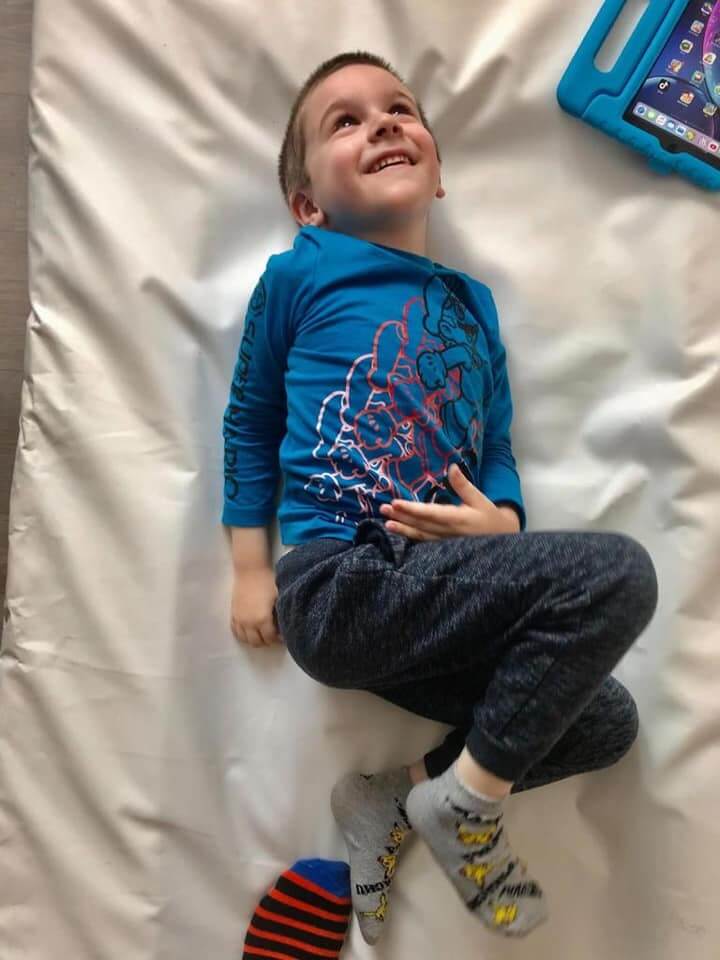Massage and autistic children
Massage can be hugely beneficial for children on the autistic spectrum. Massage provides proprioceptive input, which can help regulate our child’s sensory system. It is also a lovely non-verbal way to promote bonding and connection. Some autistic children and young people are sensitive to touch, making massage challenging! In these cases, it is very important to respect our child’s boundaries; we should never force anything unessential on our child that they actively dislike. However, with some gentle perseverance, it is possible to find a way to massage a touch-avoidant child. Some children hate light touch but really enjoy firm touch and deep pressure. Some children don’t like being touched with hands but like the feeling of an object like a brush or a roller on their skin. If we explore touch in a fun, no-pressure way, we are more likely to be successful. Because our children enjoy activities that are familiar and predictable, building massage into our daily routine can also be helpful. Massage before bed can be a great way to help slow down the nervous system in preparation for sleep. We can enhance the experience by adding other sensory elements our child enjoys, like a darkened room, colourful lights or projections on the ceiling, soft music or ambient noise, a pleasurable scent from essential oils (lavender and vetiver are good choices), or a fluffy blanket to lie on. The idea of learning to massage can be daunting, but it doesn’t need to be complicated. There is lots of great information out there to help us get started, and we share some of this below. |

Help us #MakeItHappen!

Child/Caregiver Bonding
Massage offers a lovely opportunity for bonding. Gentle, relaxing touch is a great non-verbal way to communicate tenderness and care, and build the connection between child and caregiver. It promotes secure attachment, releases feel-good hormones and helps our child feel loved and cherished.
Wakes up bodies
For children who are not very sensitive (hyposensitive) to touch, massage can help wake up their bodies and muscles – improving coordination and movement skills as their body awareness grows.
Reduces Sensitivities
For children who are tactile defensive, massage (if tolerated) can help to desensitise the skin. Firm touch can be preferable to gentle, while oil can make massage more comfortable. If your child doesn’t like hands, you can try using other implements: brushes, rollers or vibration devices, for example. It is important to respect your child’s boundaries, so if they resist or are unhappy, stop the massage and try again another day.
Calming and Regulating
Massage helps regulate the nervous system. For children who are always on the go with lots of energy, massage can be calming, encourage stillness and help with concentration. An active child might not be able to remain still for an entire body massage, but even working on a single limb can be helpful.
Heightening Physical Awareness
Communication is really important. If your child can understand language, talk to them throughout the massage, telling them what you are doing. This is a great way to teach them about their bodies and help heighten their awareness of what they are feeling. Better body knowledge helps with movement and coordination, while the loving touch of massage can be helpful for self esteem.
This video series by KidCare Canada offers a great introduction to massage, with advice on techniques. While the focus is for babies up to 6 months of age, the principles apply for all ages.
This 45 minute video takes you through a whole-body massage series with explanations of different techniques. Again, the video was created with babies in mind but the massage offered would still benefit older children.
If your child is receptive and calm you might be able to give them the entire massage while you follow along the video. However if you can only offer massage in small sections – even one leg or arm at a time – they will still feel the benefit.
If your child is older do feel free to pause the video to make sure you have time to cover the whole body in your massage -going slowly is more beneficial than rushing to keep up.
Singing is a nice addition to the massage series. If you do the massage regularly the songs will offer an aural cue as to what is coming/what to expect which can be comforting. However it is by no means essential: if your child does not like singing, you don’t have to sing. If the songs themselves are a problem you can switch to their favourites or something more age appropriate.
Here an Occupational Therapist shares a quick and simple calming massage series. It’s great for children who are over-stimulated or excited, and very helpful before bed or when they need to concentrate.
This video demonstrates hand and lower arm massage techniques. It is lovely for children with tight or floppy hands. It can also be useful to wake up the body before messy play and fine motor activities.
You can also find great hand massaging techniques on our messy play,hand-eye coordination and fine motor pages.
Have your child lie down (face up or down). Gently roll the therapy ball along their body up from their feet, being careful not to put too much pressure on their abdomen. Roll the ball across each arm and ask if they want to try how it feels on their head (not face!). Check with your child if they want more pressure or less (harder or softer).
Sometimes therapists call this “cookie dough”- you can think of your own name for the activity together. Many children find this very calming and it can be helpful before bedtime or when feeling overwhelmed by stresses during the day.
Using the therapy ball can help make this “safe” for carers or other adults to provide the benefits of massage without direct physical contact, which may be helpful in school or other circumstances. It’s also great for children who don’t like being touched.





